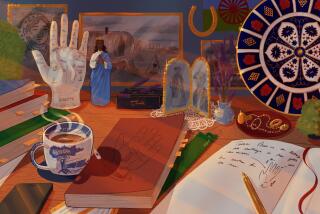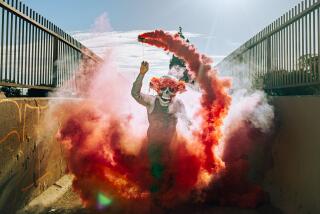Grand Illusions : Handmade <i> Carnevale </i> Masks Are Modestly Priced Collectors’ Items
VENICE, Italy — I’m standing in La Bottega dei Mascareri, a tiny mask-making studio in the shadow of Venice’s Rialto Bridge. The proprietor, Sergio Boldrin, is chatting amiably with customers as he applies a wash of white tempera to a cartapesta (papier-mache) face that will, by week’s end, join the staggering cavalcade of creatures looking down at me from walls, shelves and cases.
High above, a gold-faced and green-haired Medusa hangs just far enough away that I feel safe from her glare. A row of black and white Jokers gazes pleasantly at the crescent moons, gilt unicorns and elaborately coiffed, resplendent ladies across the way. Brightly painted commedia dell’arte characters (Pantaloon, Harlequin and company) parade across the shelf to my left, providing an illustrated history of the well-known Italian masked comedy from which so many of the popular masks are derived. Every surface in the shop--less than 10 feet square--is taken up with finished products or tools of the trade: stacks of paper, glue pots, a variety of paintbrushes and watercolors.
There are an estimated 200 shops selling masks in Venice but only about 15 mask-makers use the traditional techniques. Of the 10 or so mask artists and, perhaps, 100 shops I have visited, there are three that I enjoy revisiting because of the beauty of their work, their reasonable prices and because the mask-makers seem to like to discuss their work, endowing me, for my efforts, with an education, as well as a mask. Fortunately, I speak Italian but there almost always seems to be someone in each of the shops who speaks English.
Though I am here in the fall of 1993 and the annual carnevale is still four months away--this year, Feb. 5-15--production is already in high gear. For a Venetian, the mask-maker assumes prime importance as February blows in and brings carnevale (carnival) with it. Yet for the average tourist--and especially for a devotee of the art like me--mask shopping is a year-round delight.
When I leave La Bottega dei Mascareri, I’ll catch a vaporetto and cruise to the Ca’Rezzonico stop for a visit to Ca’ Macana, another of my favorite mask-making workshops. After that I will probably take the 20-minute stroll through the tiny alleys near Campo San Polo to another shop--the endlessly fascinating Tragicomica, where the selection of fine handiwork is so overwhelming that I sometimes spend half the afternoon trying to make a selection.
For now, I look around La Bottega dei Mascareri as Boldrin holds forth in his charming and knowledgeable way, his paintbrush in constant motion as he speaks, and I try to decide which mask to buy. I finally settle on one of the commedia figures: Boldrin insists that I choose Pantaloon, for “he is one of the most important characters.”
The character--a pompous, beak-nosed merchant, clad in the pantaloons that got their name from him--will soon join his cohorts on my wall at home . . . relics of past visits to Venice and the Bottega: Coviello, dancing boldly, his cape billowing from outstretched arms, and Zanni, the servant/clown (and origin of the word zany ), whose mischievous gaze and feathered turban are a delightful contrast to Pantaloon’s vain attempt at dignity.
I have a great fondness for these three particular masks that show the entire costumed character portrayed in colorful relief across their faces, but they’re certainly not alone on the wall of my New York apartment. In fact, as a result of the four trips I’ve made to Venice in as many years, my living room has begun to take on the look of a carnevale outpost.
There’s the mask of the round-faced woman I bought in Ca’ Macana four years ago, a $25 wonder almost a foot in diameter. Bold flowers cascade over the slices of yellow, red, pink and blue that intersect across her hair; her crimson lips are outlined in gold, while silver sequins trace the contours of her almond eyes.
A delicate orange, gold and black butterfly--elegant far beyond its $25 price tag--floats above a hook-nosed, stunningly three-dimensional Pulcinella I picked up at Tragicomica two years ago for $40. A graceful silver-faced Persian lady, swathed in a cloud of pink, glances up at a psychedelic sunburst from which dangle thick black ribbons (both under $30). While none of my masks set me back more than $40, and some purchased last fall were as little as $12, a mask-lover with boundless imagination and limitless funds could easily spend a hundred dollars, or several hundred, for a custom-designed creation.
I’m certainly not alone in my admiration for (and acquisition of) these uniquely Venetian products. The masks are the products of an artistic heritage that has prospered for centuries.
“Only papier-mache in Venice is the real mask,” Boldrin says. The craftsperson creates art in the time-honored manner, shaping the glue and paper mixture in a clay mold before giving it its tempera wash, watercolor embellishment and final sealing coat of hot wax.
The technique has survived for centuries and achieved great expression in the commedia dell’arte, which thrived for 200 years, beginning in the 16th Century. Many February revelers still cloak themselves in the garb of the 400-year-old characters, whose names evoke a colorful world of comedic tradition: Brighella, Pulcinella, Arlecchino, Capitano, Pantaloon, Balanzone . . . .
But disguise flourished even after the commedia declined and the theater began to abandon masks for a greater realism. It was at this time, in the mid-to-late 1700s, that the annual pre-Lenten carnival reached its height, drawing incognito revelers from all regions. For the merchant frequenting Venice’s ubiquitous gambling dens, or the lawmaker slipping off to a nocturnal liaison, the protection of the tricorno (three-cornered hat), tabarro (cape) and above all, the cloaking bautta (mask) was indispensable.
Modern-day visitors can imagine the mask-maker of yesteryear, when Venice was the party capital of Europe and its licentious carnevale a six-month affair, culminating, as it does today, with Fat Tuesday, the last day before Lent. The 18th-Century fetes began in October and featured sword dances, bear-baitings, beheadings of bulls and pigs, immense human pyramids, flower-bearing tightrope walkers and, in 1751, the sensational presentation of the first live rhinoceros to appear in Venice. So famous was the event that Pietro Longhi painted a rendering of the rhino presentation, which now hangs in the Museo del Settecento Veneziano in Ca’Rezzonico (although it is on loan to the Museo Correr through April 4).
Today’s carnevale was revived in the early 1980s by the local tourist board, which--after an absence of any official celebration for nearly 200 years--embraced the smaller parties that had always occurred and elaborated on them with a program of events. Though it is perhaps less known in North America than carnivals in New Orleans or Rio, Venice’s carnevale attracts more than 100,000 people--many of them Europeans--according to official estimates.
In the weeks just before Lent, the city is turned over to revelry as locals and visitors fill the town, clad in outrageous costumes and luxuriant masks. Dances, competitions, masked balls, theatrical presentations and other spectacles are presented day and night, though the real delights lie in the spontaneous and free-wheeling displays by masked celebrators on every corner.
The idea of disguise still appeals, and the range of possibilities is unlimited, as I realize on my annual pilgrimage to Ca’ Macana, a lively workshop run by Carlo Brassesco who, with his partner, Mario, employs about 10 young artisans year-round for the making of masks.
Several craftspeople are always at work in the shop’s two rooms, and the merchandise is as varied as the prices. The simple masks in white, black and red run as little as $12, with most pieces in the vast inventory between $30 and $50. Brassesco describes with relish the wide selection: “All kinds of masks, large and small, theatrical masks, traditional carnival masks, styles popular in the Middle Ages, and also masks of fantasia. We can make anything to order.” The shop hums with the bustle of the young artists, and it’s fun to whisk away a newly dry piece that has just been placed on the shelf.
At Tragicomica, the affable and accomplished Gualtiero Dall’Osto creates not only masks but complete costumes, as well. “Historical, traditional, fantasy masks,” Dall’Osto recites the litany with infectious enthusiasm, as a stunning parade of noblemen, grand ladies, zodiac-inspired figures and mythical beasts nod their mute approval, “la bautta, la dama, commedia characters, masks with feathers, any individual idea that a person wants to present.”
Shall I choose a simple, white bautta ($15), or a jazzier gold-leafed version of this traditional mask ($40)? Maybe I’ll impersonate the pompous Dottore or the mustachioed braggart Capitano. Like most of Dall’Osto’s lovingly re-created commedia masks, these range from $30 to $55.
Visiting Tragicomica’s studios (there are now two) puts me in the company of such illustrious clients as Venice’s opera house La Fenice and famed Belgian choreographer Maurice Bejart. For me, the sign in Tragicomica’s window says it as well as the scowling, grinning, plumed and florid faces that peer out from the shop. Fabbrica Trasformazioni, it’s called: “Factory of Transformations.”
GUIDEBOOK
Finding Mask-Makers
La Bottega dei Mascareri, San Polo 80, a few steps from the Rialto Bridge; in Venice, telephone 522-3857.
Ca’Macana, Dorsoduro 3172 (near Ca’Rezzonico museum); tel. 520-3229.
Tragicomica, (two stores) Campiello dei Meloni 1414 (near Campo San Polo), tel. 523-5831; and on Calle dei Nomboli 2800 (opposite the Carlo Goldoni House), tel. 721-102.
For more information: Contact the Italian Government Tourist Board, 12400 Wilshire Blvd., Suite 550, Los Angeles 90025; tel. (310) 820-0098.
More to Read
The biggest entertainment stories
Get our big stories about Hollywood, film, television, music, arts, culture and more right in your inbox as soon as they publish.
You may occasionally receive promotional content from the Los Angeles Times.










